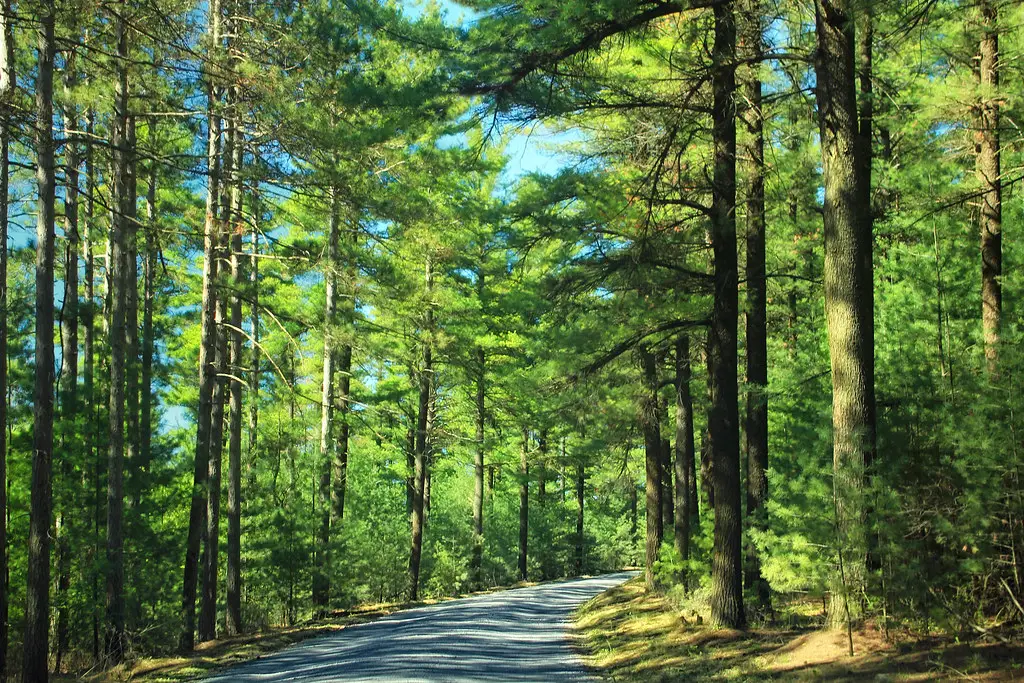White Pine, known scientifically as Pinus strobus, is the largest pine in the United States and a prominent feature in the eastern part of the country. Its towering presence, symmetrical shape, and soft, bluish-green needles have made it a favorite in landscapes and a critical component of various ecosystems. As a symbol of the northeastern forests, the White Pine has a rich history, including playing a vital role in the shipbuilding industry during the colonial era.
The White Pine’s elegance and adaptability have cemented its status as a beloved ornamental tree. Home gardeners admire its stately beauty, and ecologists value its contribution to the environment. This majestic tree supports numerous wildlife species by providing shelter and sustenance, contributing significantly to the ecological diversity of its native regions.
The versatility of White Pine extends to its commercial applications as well. The wood of White Pine is prized for its fine grain and smooth texture, making it a preferred choice for cabinetry, furniture, and construction. Its historical and ecological significance, coupled with its beauty and utility, make the White Pine a multifaceted gem of North American forestry.
| Common Names | White Pine, Eastern White Pine, Northern White Pine |
|---|---|
| Botanical Name | Pinus strobus |
| Family | Pinaceae |
| Plant Type | Evergreen tree |
| Mature Size | 50 to 80 feet tall, 20 to 40 feet wide |
| Sun Exposure | Full sun |
| Soil Type | Well-drained, acidic to slightly alkaline soil |
| Hardiness Zones | 3 to 8 |
| Native Area | Eastern and Central North America |
White Pine Care
White Pine is a relatively low-maintenance tree that grows well in various soil types and environmental conditions. While it prefers well-drained, slightly acidic soil, it can adapt to different soil conditions. Watering is essential in the early growth stages and during prolonged dry periods.
Pruning is usually minimal and generally focuses on shaping the tree and removing dead or damaged branches. Protecting the tree from strong winds and potential diseases will ensure its health and longevity.
Light Requirement for White Pine
White Pine thrives in full sun, enjoying at least 6 hours of direct sunlight daily. Adequate exposure to sunlight encourages dense growth and a robust, healthy appearance.
Soil Requirements for White Pine
White Pine grows best in well-drained, acidic to slightly alkaline soil. While it can tolerate various soil types, including sandy and clay soils, proper drainage is vital to prevent root rot.
Water Requirements for White Pine
Regular watering is necessary for young White Pines and during dry spells. Mature trees are more drought-tolerant but will still benefit from consistent moisture, especially in hot weather.
Temperature and Humidity
White Pine is adaptable to a wide range of temperatures and humidity levels within its hardiness zones. It can withstand cold winters and moderately hot summers.
Fertilizer
Fertilization is generally not required for White Pine. If a soil test indicates a deficiency in specific nutrients, an appropriate slow-release fertilizer can be applied in early spring.
Pruning White Pine
Pruning should be done in late winter or early spring to remove dead or damaged branches and maintain the tree’s shape. Avoid excessive pruning, as it can stress the tree.
Propagating White Pine
White Pine can be propagated through seeds or cuttings. Growing from seed is more common and aligns with the tree’s natural reproductive process.
How To Grow White Pine From Seed
To grow White Pine from seed, it’s essential to stratify the seeds for proper germination. Plant the stratified seeds in a well-drained soil mixture and provide consistent moisture during the growth phase.
Common Pests & Plant Diseases
White Pine Weevil
Controlled by removing infested tips or using insecticides.
Blister Rust
This fungal disease can be managed by planting resistant varieties and proper spacing.
Common Problems With White Pine
Needle Drop
Common in fall, needle drop is natural and not a cause for concern.
Needle Blight
Caused by various fungi, proper watering and spacing can prevent this issue.
Pro Tips
- Consider the mature size of White Pine when selecting a planting location to provide ample space for growth.
- Use windbreaks in particularly windy areas to protect the tree from potential damage.
- Enjoy the year-round beauty of White Pine by planting it in a visible location in your landscape.
- Monitor the tree for signs of pests or diseases, and address them promptly to maintain the tree’s health and appearance.




